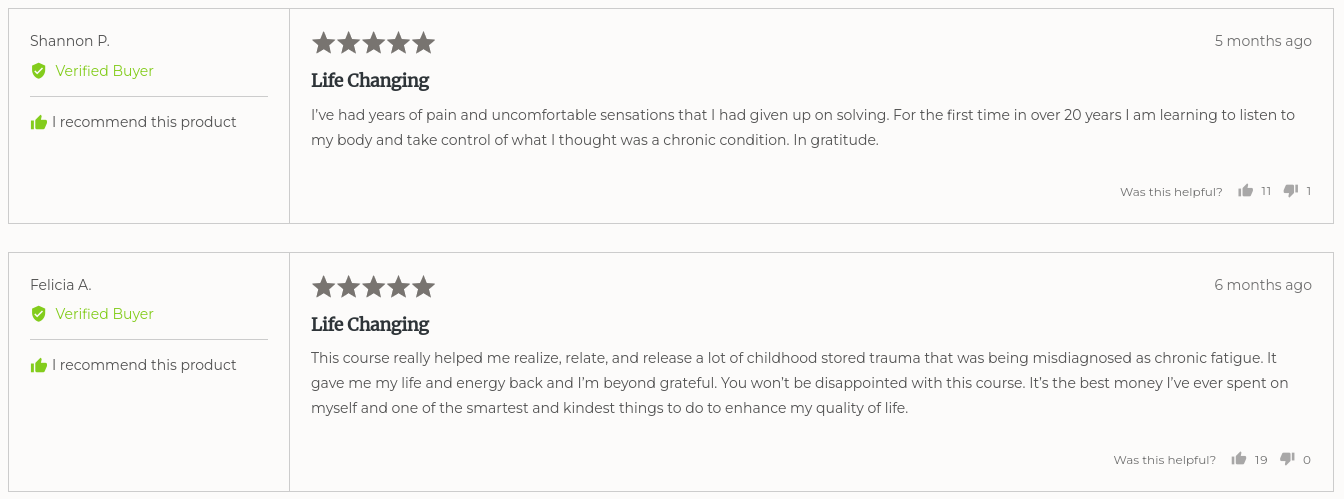This post will be updated soon with a Frequently Asked Questions section and more resources 🙂
In this video we share our experience with trauma; from my dissociation to Skyler’s chronic back pain from when he wrestled.
We also share our experience with Peter Levine and IFS. We discuss how childhood trauma has impacted our lives and how working with Levine and IFS has helped us to heal.
What is Peter Levine’s model of trauma?
Peter Levine’s model of trauma, known as Somatic Experiencing, is a revolutionary approach to healing trauma and restoring balance in the body. This psychobiological approach helps traumatized individuals understand how their bodies can heal and function normally again.
By working with the brain and nervous system, Levine’s model helps to awaken the body’s natural healing response through processes such as tracking sensations and titrating emotions.
My brother and I note in the podcast above, however, Internal Family Systems can provide additional frameworks for working with trauma.
Through IFS and other self-regulation techniques, clients are able to release stored tension and trauma symptoms accumulated through exposure to past events.
Ultimately, this model promotes a sense of safety and re-connects an individual with their true resilient self by reconnecting them with their wisdom held in the body.
Is Peter Levine a therapist?
Dr. Peter A. Levine, Ph.D., is a clinical psychologist and an internationally recognized expert in the field of trauma and trauma therapy.
He is the author of Healing Trauma: A Pioneering Program for Restoring the Wisdom of Your Body (2009).
Dr. Levine has studied and taught about trauma for over 40 years, combining his observations from animals in the wild with his clinical work with humans to create his renowned Somatic Experiencing approach – a form of body-centered psychotherapy designed to help people resolve past traumas.

He has several books that contain essential methods on how to handle various traumatic issues. Most of his works serve as parent’s guide and personal how to guide manuals. Some of them include the highly acclaimed works like “Waking The Tiger”.

What is trauma?
According to Dr. Peter Levine, trauma is the result of an experience when our body’s natural responses are overridden and instead of expressing itself, the energy gets “stuck” in the nervous system.
This can cause physical, emotional and psychological symptoms such as intrusive thoughts, flashbacks and withdrawal from people and activities.
Trauma could be caused by traumatic events like an accident or abuse, but it can also come from seemingly harmless experiences like a job interview gone wrong or a difficult conversation with a pare.
Trauma symptoms
Trauma can manifest in many different ways, and the symptoms vary depending on the individual. According to Dr. Peter Levine, author of Healing Trauma: A Pioneering Program for Restoring the Wisdom of Your Body, some common symptoms of trauma include:
- physical arousal, such as a racing heart or difficulty breathing
- emotional responses like fear, anger, or guilt
- cognitive changes like confusion or difficulty concentrating
- Other physical symptoms may include insomnia or nightmares, fatigue, being startled easily, edginess and agitation, and unexplained aches and pains.
- I would like to add as well, compulsive behaviors, or triggers
It is important to note that trauma can affect people differently based on their individual experiences and circumstances.
It is also important to seek professional help if you are experiencing any of these symptoms as they can be signs of more serious conditions such as Post-traumatic Stress Disorder (PTSD).
Trauma often causes co-morbid disorders; for example, how anxiety and depression frequently combine with binge eating disorder.
Traumatic Events
Examples of traumatic events can include:
- physical or sexual abuse
- violence
- war and disasters
- life threatening accidents or illnesses
- abandonment or neglect
- any other kind of sudden or severe event that causes immense levels of fear and distress
- bullying

Why is trauma healing important
- Trauma healing is an incredibly important process for anyone who has suffered a traumatic event or series of events.
- It provides individuals with the opportunity to gain insight, understanding and even transformation around difficult past experiences and it helps them process painful emotions in a safe and healthy way.
- Learning to recognize triggers, understanding the roots of trauma, recognizing signs of anxiety or depression and developing resiliency skills are key parts of coming through trauma in a positive, meaningful way.
- Trauma healing allows survivors to redefine their identities; it offers hope for being able to embrace life fully after being hurt deeply.
- Through cultivating patience and kindness for themselves along with perspective-taking about what happened trauma healing can empower individuals to find peace within themselves again.
How long does healing take from trauma?
According to Dr. Peter Levine, healing from trauma takes time and can depend on the individual’s unique circumstances. He states that it is important to first build a safe environment and find compassionate support in order to facilitate strong emotional healing. Once a person is empowered with those tools, they can begin the process of both short-term and long-term recovery.
Can anyone ever completely heal from trauma?
Trauma should not be seen as a life sentence. Regardless of how long you’ve been enduring lifelong symptoms ranging from chronic pain to obsessive thinking to compulsive eating, there is a possibility of full recovery. It may take a long time to get to that point, but it is always worth it in the end.
How do you heal yourself from trauma books?
Reading books may be effective personal guides to release traumatic experiences. When you read trauma books, you discover various methods that can help address your current situation. You also get to appreciate the wisdom of your body via the lenses of others. However, trauma is immensely difficult and confusing (like binge eating), so you will most likely want to work with a counselor who specializes in trauma.
What is healing in trauma?
According to Dr. Peter Levine, healing in trauma involves completing the physiological cycle of shock and stress by allowing the body’s natural response of shaking, trembling, and crying. Through this process, the nervous system can come back into balance, thus restoring an individual to a state of health and wellbeing.
What is a trauma healer?
A trauma healer is a type of practitioner who specializes in helping individuals heal from the traumatic effects of life experiences. This work often involves providing compassionate guidance, educating the individual on how to manage difficult emotions, and supporting them through the process of recovery.
What does trauma healing feel like?
According to Dr. Peter Levine, trauma healing feels like a process of re-integrating the body and mind. He has likened the experience to being “out of the fog” and “rediscovering joy” as one grows in awareness, understanding, and self-compassion.
Can someone heal your trauma?
Yes, with the right kind of help, it is possible to heal from trauma. Of course, you must ultimately go through healing yourself, and this is a uniquely individual experience.
Part of this healing process usually includes talking through your experiences with a qualified therapist, attending group therapy sessions, learning coping strategies, and practicing mindfulness. With patience and dedication, healing is possible.
How do you heal from trauma spiritually?
Healing from trauma spiritually can be achieved through various practices such as meditation, mindfulness, prayer, visualization, and energy healing. These techniques may help to reduce stress levels and provide access to inner resources that can help one process their traumatic experiences and find hope. Additionally, connecting with a higher power or engaging in spiritual conversations can bring strength and peace.
Does trauma ever fully heal?
Trauma can often be healed, but it is a complex process that requires time and effort. Though people may endure lifelong symptoms ranging in severity from the trauma, healing is possible with self-care, therapy, and support from loved ones. It’s important to remember to be kind and gentle to oneself during the healing process, as this may help create space for lasting transformation.

Where do I start with healing trauma?
If you’ve experienced a traumatic event, the search for healing can be daunting. It’s essential to keep in mind that everyone’s trauma response and needs are different, so there is no one-size-fits-all approach to healing. That said, building a strong support system is critical. Seek out trusted family members or friends, mental health professionals, religious and spiritual leaders, as well as any other people who are understanding and can provide emotional support.
My journey started with a commitment to practice mindfulness, build a strong and supportive community, and understand the fundamentals of good nutrition. By grounding myself securely in these tools, I was able to start exploring these deeply rooted issues from a solid foundation. Through this process I found that I began to feel my own self-worth and could move forward with more clarity on this healing trauma path.
What are the steps to healing trauma?
In chapter 4, Levine presents an extensive program that seeks to assist individuals struggling with trauma so they can unleash their energy and bring back balance into their bodies.
It’s important to note that the person should proceed through the program at a rate appropriate for them. A brief overview of the program is outlined below:
- Safety and Containment Exercises: These exercises help to create a sense of safety by regulating the intensity of emotions and providing support whilst exploring difficult memories and feelings.
- Grounding and Centering: This involves engaging with the body, calming the breath, setting boundaries and connecting with one’s environment in order to self-regulate.
- Building Resources: This step helps to build strength and resilience through activities such as exercise, yoga, mindfulness, nature walks or any other practice that grounds an individual in their body.
- From “Felt Sense” to Tracking Specific Sensations: This step encourages tracking physical sensations in order to gain insight into what is happening inside of one’s body in response to trauma or stressor triggers.
- Tracking Activation: Sensations, Images, Thoughts, and Emotions: Understanding the full picture of how trauma manifests for each individual including how thoughts, images, sounds and sensations express themselves is key for healing memories from the past and regaining a sense of safety in the present moment.
- Pendulation: Tracking Your Rhythms of Expansion and Contraction: Through this step individuals learn how to recognize patterns of expansion within their body as well as moments of contraction in order to stay connected with both fear and safety while processing traumatic material at a manageable pace.
- Fight Response: Natural Aggression versus Violence: Learning natural aggression (e.g., active defending) rather than violent responses helps one respond appropriately when feeling overwhelmed instead of resorting to defensive strategies such as withdrawl or aggression towards oneself or others.
- Flight Response: Natural Escape versus Anxiety: Learning natural escape (e.g., taking flight) rather than anxious responses helps one respond appropriately when feeling overwhelmed instead of resorting to defensive strategies such as freeze, unexplained physical pain, or collapse which can be debilitating when experienced on a regular basis.
- Strength and Resiliency versus Collapse and Defeat : Recognizing inner resources such as courage, strength, and assertiveness builds connection between these resources which strengthens resiliency.
- Uncoupling Fear from the Immobility Response: Encouraging an individual who has been frozen by fear/threat resulting from traumatic events can greatly reduce emotional overwhelm. Identifying what triggers immobility will also assist healing.
- Orientation: Moving from Internal to External Environment and Social Engagement : Orienting oneself back out into external environments after experiencing shock encourages healthy interactions with people, places, and things. It can provide perspective on life’s circumstances leading back into contact with one’s community, family, job, etc.
- Settling & Integrating: Acknowledging all that has been experienced during treatment supports deeper integration allowing individuals time to reflect on growth while not focusing solely on deficits stemming from trauma. Reflection is important for sustaining change.
What are the 4 tips for healing from trauma?
There are tips (and general principles) that can help to actively overcome traumas. These tips are efficient and reliable regardless of the type and stage of the unresolved trauma.
- Acknowledging and identifying your trauma: This first tip can help heal traumas easily. Most traumatized people don’t know what they are dealing with. Often times they refuse to listen to their body awareness.
- Understanding trauma is a psychological form of first aid: It helps in resolving trauma when you realize trauma is protective and has positive intentions. You further develop body awareness and safety which goes a long way to create physiological stability.
- Asking for support: This is another helpful tip. Reaching out to trauma therapists and certified training practitioners is of utmost necessity for healing trauma. Other trauma survivors can also be part of your support systems.
- Connect with others: Bonding and making connections with others is one of the essential methods to actively overcome childhood trauma and others. Socializing, joining clubs and organizations can even help in instilling confidence.
How do you release somatic trauma?
Releasing somatic trauma involves addressing the physical sensations that come with experiencing traumatic events.
This may include acknowledging and understanding the body’s sensations, engaging in deep breathing exercises, relaxation techniques such as progressive muscle relaxation, and using visualization to access deeper layers of emotion.

What does Somatic Experiencing Therapy look like?
Somatic Experiencing (SE) is a body-awareness approach to healing trauma that was developed by Dr. Peter Levine. SE helps people process and release unresolved stress and trauma stored in the body through gentle, mindful awareness techniques.
At its core, Somatic Experiencing is an experiential therapy that relies on the individual’s ability to become aware of their body’s physical sensations and then use those sensations to facilitate healing from trauma, and to address unexplained symptoms related to trauma.
It involves a variety of mindful awareness practices such as slow breathing, progressive muscle relaxation, guided imagery, and more. Through these practices, individuals learn to regulate their own nervous system responses so they can better manage stress and anxiety.
The Science Behind It
Somatic Experiencing is grounded in neuroscience research which has found that traumatic experiences can cause a disruption in our body’s natural response systems. This disruption can manifest itself as a number of physical symptoms including chronic pain, fatigue, difficulty sleeping, digestive issues, binge eating or ‘food addiction’, and even depression or anxiety.
By working with SE practitioners to identify these dysregulated areas within the body, individuals are better able to access their own internal resources which can help them heal from trauma in a safe and supportive environment.
Dr. Peter Levine’s Methodology
Dr. Peter Levine developed SE after years of studying animal behavior and how they naturally release stressful energy following a traumatic event (such as being chased by predators). He observed that animals use movements such as shaking or running to help them recover from the shock of traumatic experiences quickly without any lasting negative effects.
He then adapted this same approach for humans who have experienced trauma – allowing them to reconnect with their bodies in order to gain control over their own responses and ultimately find relief from the impact of traumatic events on both mind and body.
How do you start self healing trauma?
Sinking back into the traumatic moods and spaces is a common occurrence, especially if there is generational trauma. However, here some ways in which emotional relapse be prevented.
- Exercises: When trauma affects your body, exercise and movement can improve brain function. It helps you stay top of your self care game. Exercise is a kind of physical first aid.
- Actively engage your support system: It is advisable not to go on a healing journey alone. You need to have some people in your corner to prevent your from relapsing. Having a support system will speed up your healing process.
- Practice self awareness: It is another tested and trusted way to prevent emotional relapse. Constantly practice self awareness. Resist the urge to suppress your feeling. Instead meditate and journal to address the feelings or thoughts.
The Healing Trauma Online Course: A Step-by-Step Program for Restoring the Wisdom of the Body

Do you suffer from unexplained physical problems, emotional issues, or psychological blockages? Has your natural instinct to deal with trauma been overridden by cultural training?
If so, Dr. Peter Levine’s breakthrough techniques may be the answer. In his empowering online training course entitled “The Healing Trauma”, he shares an in-depth program for restoring a harmonious balance to your body and mind.
Drawing upon more than 40 years of research and containing more than seven hours of expert guidance, plus Dr. Levine’s answers to past participant questions, this comprehensive course will help you understand how you can release unresolved traumas and live more fully through nature’s lessons on returning to equilibrium and balance.
In this step-by-step program, Dr. Levine guides participants through each of the essential principles of the four-phase process he calls Somatic Experiencing, helping them identify where they are storing distress in their bodies and become aware of their physiological responses to danger.
With exercises that build resilience for future challenges and practices and exercises to resolve past traumas without “reliving” or consciously remembering an event, participants can learn how to address symptoms at their source—the body—and return it to its natural state.
What I loved about the course is how right away Dr. Levine provides insight into why moving energy from seemingly minor events can yield big results and access information about anxiety insomnia, depression, and unexplained pain when trauma may be the cause.
Participating in this program could be the first step in restoring wholeness and feeling stronger while reconnecting with inherent aliveness—all thanks to Dr. Levine’s groundbreaking approach!
As you can tell from the podcast above, I’ve definitely learned a lot from this approach and feel incredibly grateful 🙂
Reviews
The course gets 5/5 from 11 ratings on Sounds True.

Additional Resources
- If you want to hear first when new pieces of therapeutic content are released, please check out the private community here.
- If you want to hear Dr. Levine go through various exercises and breakdown trauma, listen to a free snippet from “Healing Trauma” with Amazon Audible .
- Check out Dr. Levine’s course on SoundCloud “The Healing Trauma Online Course: A Step-by-Step Program for Restoring the Wisdom of the Body”
- If you specifically struggle with binge and emotional eating, see our “Enlighten Eats” Online Course – 3 stages to heal the underlying causes of binge eating.




